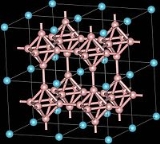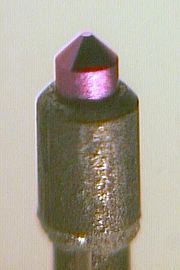
Lanthanum hexaboride
Encyclopedia

]
Lanthanum hexaboride (La
Lanthanum
Lanthanum is a chemical element with the symbol La and atomic number 57.Lanthanum is a silvery white metallic element that belongs to group 3 of the periodic table and is the first element of the lanthanide series. It is found in some rare-earth minerals, usually in combination with cerium and...
B
Boron
Boron is the chemical element with atomic number 5 and the chemical symbol B. Boron is a metalloid. Because boron is not produced by stellar nucleosynthesis, it is a low-abundance element in both the solar system and the Earth's crust. However, boron is concentrated on Earth by the...
6, also called lanthanum boride and LaB) is an inorganic chemical, a boride
Boride
In chemistry a boride is a chemical compound between boron and a less electronegative element, for example silicon boride . The borides are a very large group of compounds that are generally high melting and are not ionic in nature. Some borides exhibit very useful physical properties. The term...
of lanthanum
Lanthanum
Lanthanum is a chemical element with the symbol La and atomic number 57.Lanthanum is a silvery white metallic element that belongs to group 3 of the periodic table and is the first element of the lanthanide series. It is found in some rare-earth minerals, usually in combination with cerium and...
. It is a refractory
Refractory
A refractory material is one that retains its strength at high temperatures. ASTM C71 defines refractories as "non-metallic materials having those chemical and physical properties that make them applicable for structures, or as components of systems, that are exposed to environments above...
ceramic
Ceramic
A ceramic is an inorganic, nonmetallic solid prepared by the action of heat and subsequent cooling. Ceramic materials may have a crystalline or partly crystalline structure, or may be amorphous...
material that has a melting point of 2210 °C, and is insoluble in water and hydrochloric acid
Hydrochloric acid
Hydrochloric acid is a solution of hydrogen chloride in water, that is a highly corrosive, strong mineral acid with many industrial uses. It is found naturally in gastric acid....
. It has a low work function
Work function
In solid-state physics, the work function is the minimum energy needed to remove an electron from a solid to a point immediately outside the solid surface...
and one of the highest electron
Electron
The electron is a subatomic particle with a negative elementary electric charge. It has no known components or substructure; in other words, it is generally thought to be an elementary particle. An electron has a mass that is approximately 1/1836 that of the proton...
emissivities known, and is stable in vacuum
Vacuum
In everyday usage, vacuum is a volume of space that is essentially empty of matter, such that its gaseous pressure is much less than atmospheric pressure. The word comes from the Latin term for "empty". A perfect vacuum would be one with no particles in it at all, which is impossible to achieve in...
. Stoichiometric samples are colored intense purple-violet, while boron-rich ones (above LaB6.07) are blue. Ion bombardment changes its color from purple to emerald green.
The principal use of lanthanum hexaboride is in hot cathode
Hot cathode
In vacuum tubes, a hot cathode is a cathode electrode which emits electrons due to thermionic emission. In the accelerator community, these are referred to as thermionic cathodes. The heating element is usually an electrical filament...
s, either as a single crystal or as a coating deposited by physical vapor deposition
Physical vapor deposition
Physical vapor deposition is a variety of vacuum deposition and is a general term used to describe any of a variety of methods to deposit thin films by the condensation of a vaporized form of the desired film material onto various workpiece surfaces...
. Hexaborides, such as lanthanum hexaboride (LaB6) and cerium hexaboride
Cerium hexaboride
]Cerium hexaboride is an inorganic chemical, a boride of cerium. It is a refractory ceramic material. It has low work function and one of the highest electron emissivity known, and is stable in vacuum...
(CeB6), have low work function
Work function
In solid-state physics, the work function is the minimum energy needed to remove an electron from a solid to a point immediately outside the solid surface...
s, around 2.5 eV
Electronvolt
In physics, the electron volt is a unit of energy equal to approximately joule . By definition, it is equal to the amount of kinetic energy gained by a single unbound electron when it accelerates through an electric potential difference of one volt...
. They are also somewhat resistant to cathode poisoning. Cerium hexaboride cathodes have a lower evaporation rate at 1700 K than lanthanum hexaboride, but they become equal at temperatures above 1850 K. Cerium hexaboride cathodes have one and half the lifetime of lanthanum hexaboride, due to the former's higher resistance to carbon contamination. Hexaboride cathodes are about ten times "brighter" than tungsten
Tungsten
Tungsten , also known as wolfram , is a chemical element with the chemical symbol W and atomic number 74.A hard, rare metal under standard conditions when uncombined, tungsten is found naturally on Earth only in chemical compounds. It was identified as a new element in 1781, and first isolated as...
cathodes, and have 10-15 times longer lifetime. Devices and techniques in which hexaboride cathodes are used include electron microscope
Electron microscope
An electron microscope is a type of microscope that uses a beam of electrons to illuminate the specimen and produce a magnified image. Electron microscopes have a greater resolving power than a light-powered optical microscope, because electrons have wavelengths about 100,000 times shorter than...
s, microwave tubes, electron lithography, electron beam welding
Electron beam welding
Electron beam welding is a fusion welding process in which a beam of high-velocity electrons is applied to the materials being joined. The workpieces melt as the kinetic energy of the electrons is transformed into heat upon impact, and the filler metal, if used, also melts to form part of the weld...
, X-ray tube
X-ray tube
An X-ray tube is a vacuum tube that produces X-rays. They are used in X-ray machines. X-rays are part of the electromagnetic spectrum, an ionizing radiation with wavelengths shorter than ultraviolet light...
s, and free electron laser
Free electron laser
A free-electron laser, or FEL, is a laser that shares the same optical properties as conventional lasers such as emitting a beam consisting of coherent electromagnetic radiation which can reach high power, but which uses some very different operating principles to form the beam...
s. Lanthanum hexaboride slowly evaporates from the heated cathodes and forms deposits on the Wehnelt cylinder
Wehnelt cylinder
A Wehnelt cylinder is an electrode in the electron gun assembly of some thermionic devices, used for focusing and control of the electron beam. It is named after Arthur Rudolph Berthold Wehnelt, a German physicist, who invented it during the years 1902 and 1903. A Wehnelt cylinder is also known as...
s and apertures. LaB6 is also used as a size/strain standard in X-ray powder diffraction to calibrate instrumental broadening of diffraction peaks.
LaB6 is a superconductor with a relatively low transition temperature of 0.45 K.

